Beliefs, Awareness, and Experiences of Postpartum Depression on First-time Mothers
VerifiedAdded on 2023/06/04
|15
|4158
|439
AI Summary
This paper is a description of a research study proposal that seeks to understand the beliefs, awareness, and experiences of first-time mothers with postpartum depression. The study will achieve its goal by adopting a qualitative research approach that will be guided a phenomenological methodology framework.
Contribute Materials
Your contribution can guide someone’s learning journey. Share your
documents today.

Running head: POSTPARTUM DEPRESSION ON FIRST-TIME MOTHERS
The Beliefs, Awareness, and Experiences of Postpartum Depression on First-time Mothers
Name
Institution
The Beliefs, Awareness, and Experiences of Postpartum Depression on First-time Mothers
Name
Institution
Secure Best Marks with AI Grader
Need help grading? Try our AI Grader for instant feedback on your assignments.
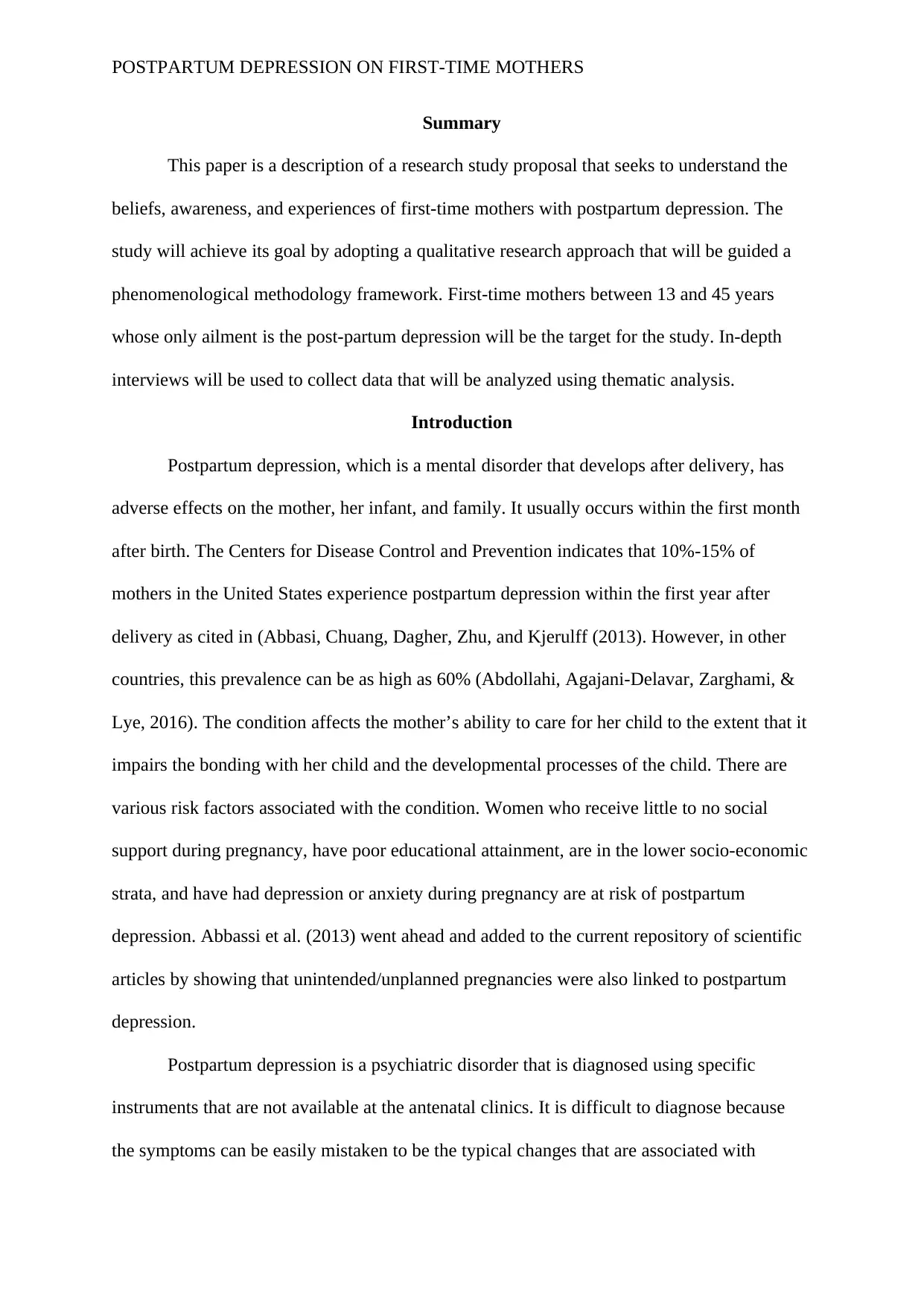
POSTPARTUM DEPRESSION ON FIRST-TIME MOTHERS
Summary
This paper is a description of a research study proposal that seeks to understand the
beliefs, awareness, and experiences of first-time mothers with postpartum depression. The
study will achieve its goal by adopting a qualitative research approach that will be guided a
phenomenological methodology framework. First-time mothers between 13 and 45 years
whose only ailment is the post-partum depression will be the target for the study. In-depth
interviews will be used to collect data that will be analyzed using thematic analysis.
Introduction
Postpartum depression, which is a mental disorder that develops after delivery, has
adverse effects on the mother, her infant, and family. It usually occurs within the first month
after birth. The Centers for Disease Control and Prevention indicates that 10%-15% of
mothers in the United States experience postpartum depression within the first year after
delivery as cited in (Abbasi, Chuang, Dagher, Zhu, and Kjerulff (2013). However, in other
countries, this prevalence can be as high as 60% (Abdollahi, Agajani-Delavar, Zarghami, &
Lye, 2016). The condition affects the mother’s ability to care for her child to the extent that it
impairs the bonding with her child and the developmental processes of the child. There are
various risk factors associated with the condition. Women who receive little to no social
support during pregnancy, have poor educational attainment, are in the lower socio-economic
strata, and have had depression or anxiety during pregnancy are at risk of postpartum
depression. Abbassi et al. (2013) went ahead and added to the current repository of scientific
articles by showing that unintended/unplanned pregnancies were also linked to postpartum
depression.
Postpartum depression is a psychiatric disorder that is diagnosed using specific
instruments that are not available at the antenatal clinics. It is difficult to diagnose because
the symptoms can be easily mistaken to be the typical changes that are associated with
Summary
This paper is a description of a research study proposal that seeks to understand the
beliefs, awareness, and experiences of first-time mothers with postpartum depression. The
study will achieve its goal by adopting a qualitative research approach that will be guided a
phenomenological methodology framework. First-time mothers between 13 and 45 years
whose only ailment is the post-partum depression will be the target for the study. In-depth
interviews will be used to collect data that will be analyzed using thematic analysis.
Introduction
Postpartum depression, which is a mental disorder that develops after delivery, has
adverse effects on the mother, her infant, and family. It usually occurs within the first month
after birth. The Centers for Disease Control and Prevention indicates that 10%-15% of
mothers in the United States experience postpartum depression within the first year after
delivery as cited in (Abbasi, Chuang, Dagher, Zhu, and Kjerulff (2013). However, in other
countries, this prevalence can be as high as 60% (Abdollahi, Agajani-Delavar, Zarghami, &
Lye, 2016). The condition affects the mother’s ability to care for her child to the extent that it
impairs the bonding with her child and the developmental processes of the child. There are
various risk factors associated with the condition. Women who receive little to no social
support during pregnancy, have poor educational attainment, are in the lower socio-economic
strata, and have had depression or anxiety during pregnancy are at risk of postpartum
depression. Abbassi et al. (2013) went ahead and added to the current repository of scientific
articles by showing that unintended/unplanned pregnancies were also linked to postpartum
depression.
Postpartum depression is a psychiatric disorder that is diagnosed using specific
instruments that are not available at the antenatal clinics. It is difficult to diagnose because
the symptoms can be easily mistaken to be the typical changes that are associated with

POSTPARTUM DEPRESSION ON FIRST-TIME MOTHERS
pregnancy and women after birth. Therefore, women who are not able to different the normal
changes from postpartum depression might not seek treatment or seek it when the signs and
symptoms have grown out of hand. Understanding the experiences of these women will help
to understand whether intervention is timely is not; thereby, make relevant recommendations.
Despite the fact that postpartum depression is deemed to have adverse effects on both
the mother and child, there is no literature that shows screening procedures that mothers are
subjected to in view of detecting the psychiatric disorder. While postpartum depression only
affects the woman, the family and society and large are also greatly involved because the
actions projected from the two entities have a direct effect on the mother. Thereby, by
investigating the experiences of these women, it is important to understand the outer circle
that should be involved so that women who are vulnerable to the condition can receive the
support they need from all those around them.
Background and Rationale
There is paucity of evidence on the viewpoints and experiences of first-time mothers
with postpartum depression. Gao, Chan, You, and Li (2010) conducted similar study like the
current one, but the current study goes ahead to determine what these first-time mothers now
about postpartum depression to determine if they are able to relate the experiences they
receive to postpartum depression. The study by Gao et al. (2010) was conducted in China, but
the current study will take place in a different setting.
Symptoms that have been shown to manifest among mothers with postpartum
depression are mild elation, fatigue, mood swings, irritability, confusion, and high tendency
for crying (Gjerdingen & Yawn, 2007). Most mothers, and especially the first time mothers,
are not aware that they have the condition; hence, they are not able to relate these symptoms
to postpartum depression and seek treatment. It is, therefore, necessary to delve into this topic
and understand whether first-time mothers are aware of the condition. and how they approach
pregnancy and women after birth. Therefore, women who are not able to different the normal
changes from postpartum depression might not seek treatment or seek it when the signs and
symptoms have grown out of hand. Understanding the experiences of these women will help
to understand whether intervention is timely is not; thereby, make relevant recommendations.
Despite the fact that postpartum depression is deemed to have adverse effects on both
the mother and child, there is no literature that shows screening procedures that mothers are
subjected to in view of detecting the psychiatric disorder. While postpartum depression only
affects the woman, the family and society and large are also greatly involved because the
actions projected from the two entities have a direct effect on the mother. Thereby, by
investigating the experiences of these women, it is important to understand the outer circle
that should be involved so that women who are vulnerable to the condition can receive the
support they need from all those around them.
Background and Rationale
There is paucity of evidence on the viewpoints and experiences of first-time mothers
with postpartum depression. Gao, Chan, You, and Li (2010) conducted similar study like the
current one, but the current study goes ahead to determine what these first-time mothers now
about postpartum depression to determine if they are able to relate the experiences they
receive to postpartum depression. The study by Gao et al. (2010) was conducted in China, but
the current study will take place in a different setting.
Symptoms that have been shown to manifest among mothers with postpartum
depression are mild elation, fatigue, mood swings, irritability, confusion, and high tendency
for crying (Gjerdingen & Yawn, 2007). Most mothers, and especially the first time mothers,
are not aware that they have the condition; hence, they are not able to relate these symptoms
to postpartum depression and seek treatment. It is, therefore, necessary to delve into this topic
and understand whether first-time mothers are aware of the condition. and how they approach
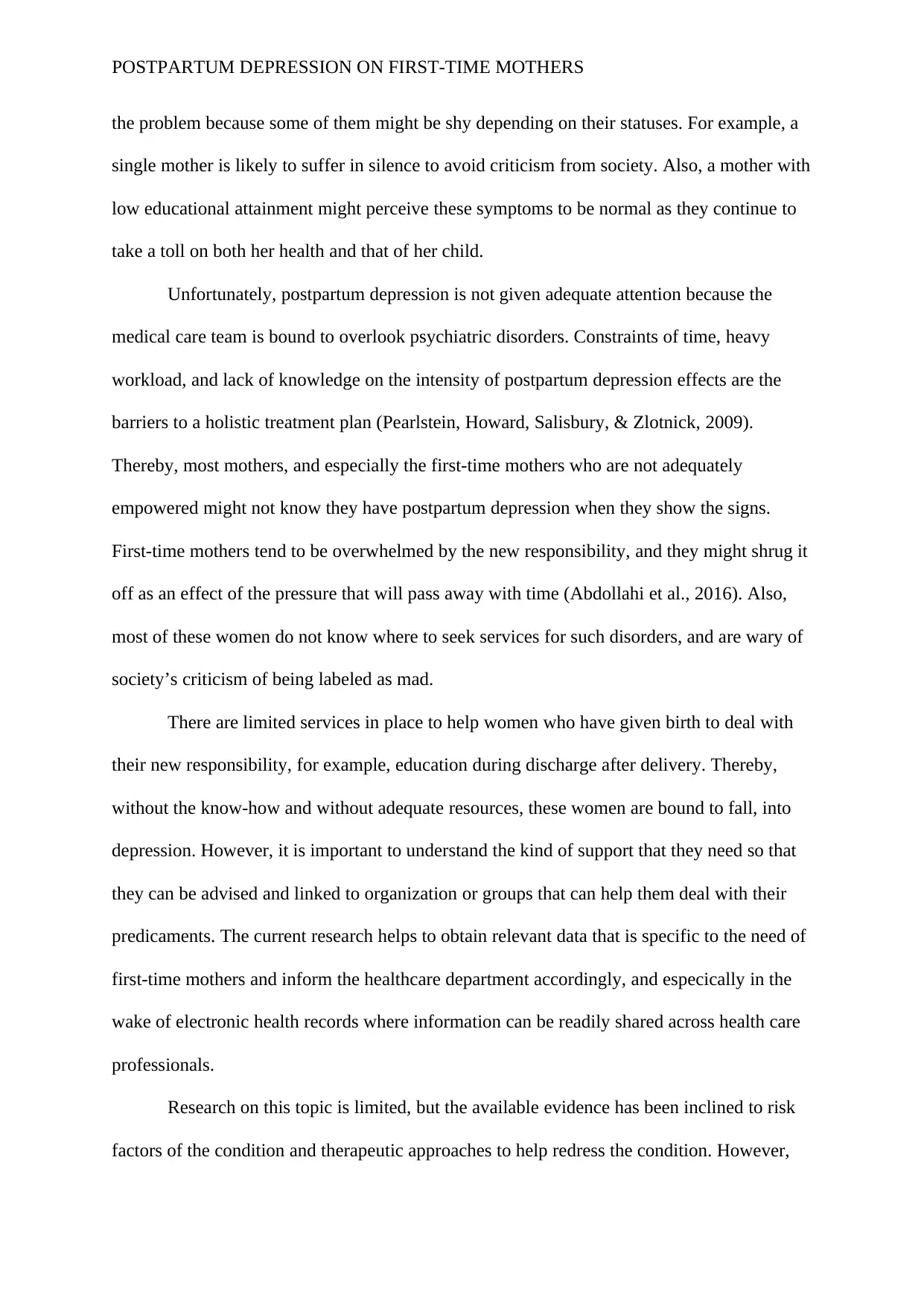
POSTPARTUM DEPRESSION ON FIRST-TIME MOTHERS
the problem because some of them might be shy depending on their statuses. For example, a
single mother is likely to suffer in silence to avoid criticism from society. Also, a mother with
low educational attainment might perceive these symptoms to be normal as they continue to
take a toll on both her health and that of her child.
Unfortunately, postpartum depression is not given adequate attention because the
medical care team is bound to overlook psychiatric disorders. Constraints of time, heavy
workload, and lack of knowledge on the intensity of postpartum depression effects are the
barriers to a holistic treatment plan (Pearlstein, Howard, Salisbury, & Zlotnick, 2009).
Thereby, most mothers, and especially the first-time mothers who are not adequately
empowered might not know they have postpartum depression when they show the signs.
First-time mothers tend to be overwhelmed by the new responsibility, and they might shrug it
off as an effect of the pressure that will pass away with time (Abdollahi et al., 2016). Also,
most of these women do not know where to seek services for such disorders, and are wary of
society’s criticism of being labeled as mad.
There are limited services in place to help women who have given birth to deal with
their new responsibility, for example, education during discharge after delivery. Thereby,
without the know-how and without adequate resources, these women are bound to fall, into
depression. However, it is important to understand the kind of support that they need so that
they can be advised and linked to organization or groups that can help them deal with their
predicaments. The current research helps to obtain relevant data that is specific to the need of
first-time mothers and inform the healthcare department accordingly, and especically in the
wake of electronic health records where information can be readily shared across health care
professionals.
Research on this topic is limited, but the available evidence has been inclined to risk
factors of the condition and therapeutic approaches to help redress the condition. However,
the problem because some of them might be shy depending on their statuses. For example, a
single mother is likely to suffer in silence to avoid criticism from society. Also, a mother with
low educational attainment might perceive these symptoms to be normal as they continue to
take a toll on both her health and that of her child.
Unfortunately, postpartum depression is not given adequate attention because the
medical care team is bound to overlook psychiatric disorders. Constraints of time, heavy
workload, and lack of knowledge on the intensity of postpartum depression effects are the
barriers to a holistic treatment plan (Pearlstein, Howard, Salisbury, & Zlotnick, 2009).
Thereby, most mothers, and especially the first-time mothers who are not adequately
empowered might not know they have postpartum depression when they show the signs.
First-time mothers tend to be overwhelmed by the new responsibility, and they might shrug it
off as an effect of the pressure that will pass away with time (Abdollahi et al., 2016). Also,
most of these women do not know where to seek services for such disorders, and are wary of
society’s criticism of being labeled as mad.
There are limited services in place to help women who have given birth to deal with
their new responsibility, for example, education during discharge after delivery. Thereby,
without the know-how and without adequate resources, these women are bound to fall, into
depression. However, it is important to understand the kind of support that they need so that
they can be advised and linked to organization or groups that can help them deal with their
predicaments. The current research helps to obtain relevant data that is specific to the need of
first-time mothers and inform the healthcare department accordingly, and especically in the
wake of electronic health records where information can be readily shared across health care
professionals.
Research on this topic is limited, but the available evidence has been inclined to risk
factors of the condition and therapeutic approaches to help redress the condition. However,
Secure Best Marks with AI Grader
Need help grading? Try our AI Grader for instant feedback on your assignments.
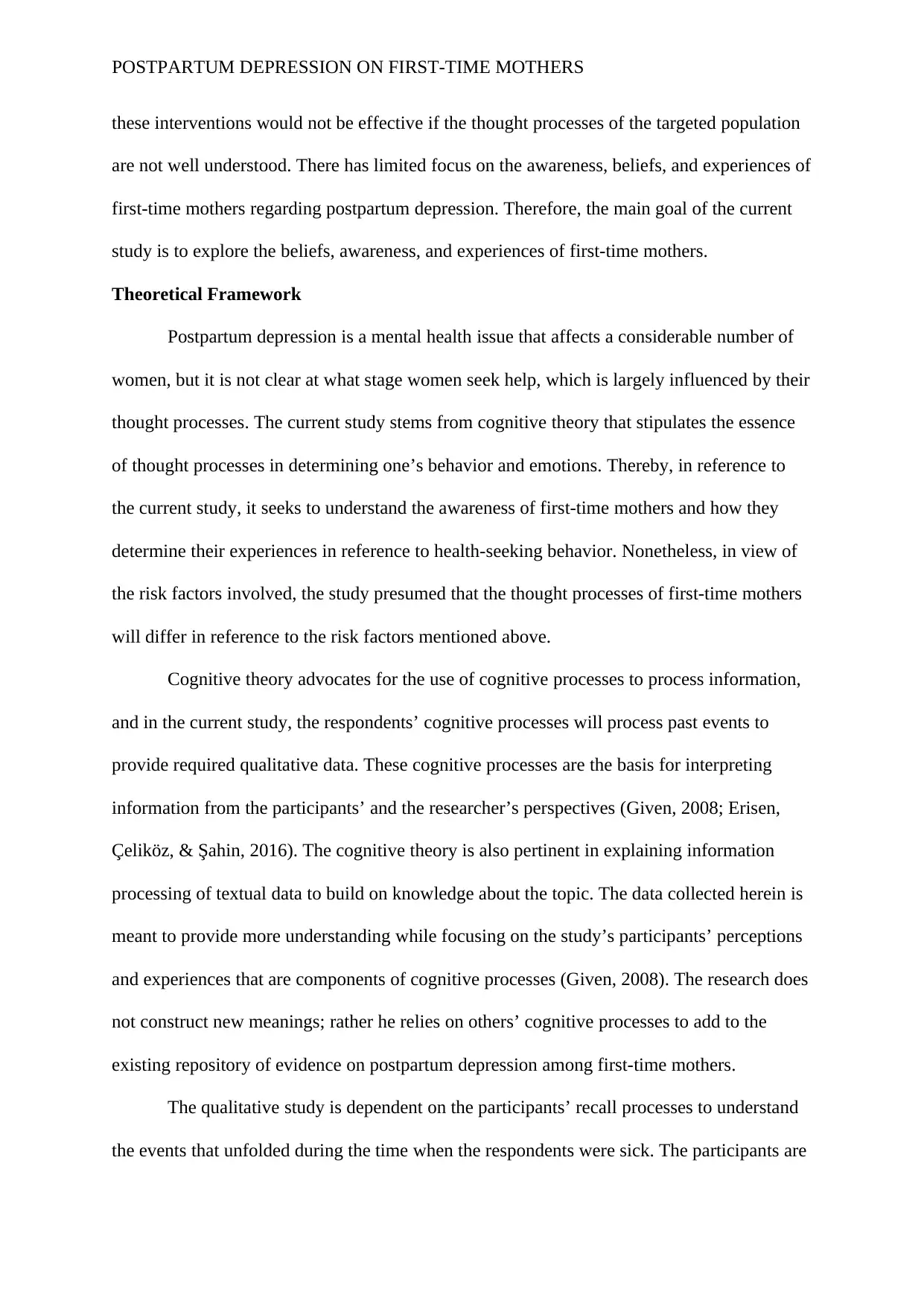
POSTPARTUM DEPRESSION ON FIRST-TIME MOTHERS
these interventions would not be effective if the thought processes of the targeted population
are not well understood. There has limited focus on the awareness, beliefs, and experiences of
first-time mothers regarding postpartum depression. Therefore, the main goal of the current
study is to explore the beliefs, awareness, and experiences of first-time mothers.
Theoretical Framework
Postpartum depression is a mental health issue that affects a considerable number of
women, but it is not clear at what stage women seek help, which is largely influenced by their
thought processes. The current study stems from cognitive theory that stipulates the essence
of thought processes in determining one’s behavior and emotions. Thereby, in reference to
the current study, it seeks to understand the awareness of first-time mothers and how they
determine their experiences in reference to health-seeking behavior. Nonetheless, in view of
the risk factors involved, the study presumed that the thought processes of first-time mothers
will differ in reference to the risk factors mentioned above.
Cognitive theory advocates for the use of cognitive processes to process information,
and in the current study, the respondents’ cognitive processes will process past events to
provide required qualitative data. These cognitive processes are the basis for interpreting
information from the participants’ and the researcher’s perspectives (Given, 2008; Erisen,
Çeliköz, & Şahin, 2016). The cognitive theory is also pertinent in explaining information
processing of textual data to build on knowledge about the topic. The data collected herein is
meant to provide more understanding while focusing on the study’s participants’ perceptions
and experiences that are components of cognitive processes (Given, 2008). The research does
not construct new meanings; rather he relies on others’ cognitive processes to add to the
existing repository of evidence on postpartum depression among first-time mothers.
The qualitative study is dependent on the participants’ recall processes to understand
the events that unfolded during the time when the respondents were sick. The participants are
these interventions would not be effective if the thought processes of the targeted population
are not well understood. There has limited focus on the awareness, beliefs, and experiences of
first-time mothers regarding postpartum depression. Therefore, the main goal of the current
study is to explore the beliefs, awareness, and experiences of first-time mothers.
Theoretical Framework
Postpartum depression is a mental health issue that affects a considerable number of
women, but it is not clear at what stage women seek help, which is largely influenced by their
thought processes. The current study stems from cognitive theory that stipulates the essence
of thought processes in determining one’s behavior and emotions. Thereby, in reference to
the current study, it seeks to understand the awareness of first-time mothers and how they
determine their experiences in reference to health-seeking behavior. Nonetheless, in view of
the risk factors involved, the study presumed that the thought processes of first-time mothers
will differ in reference to the risk factors mentioned above.
Cognitive theory advocates for the use of cognitive processes to process information,
and in the current study, the respondents’ cognitive processes will process past events to
provide required qualitative data. These cognitive processes are the basis for interpreting
information from the participants’ and the researcher’s perspectives (Given, 2008; Erisen,
Çeliköz, & Şahin, 2016). The cognitive theory is also pertinent in explaining information
processing of textual data to build on knowledge about the topic. The data collected herein is
meant to provide more understanding while focusing on the study’s participants’ perceptions
and experiences that are components of cognitive processes (Given, 2008). The research does
not construct new meanings; rather he relies on others’ cognitive processes to add to the
existing repository of evidence on postpartum depression among first-time mothers.
The qualitative study is dependent on the participants’ recall processes to understand
the events that unfolded during the time when the respondents were sick. The participants are
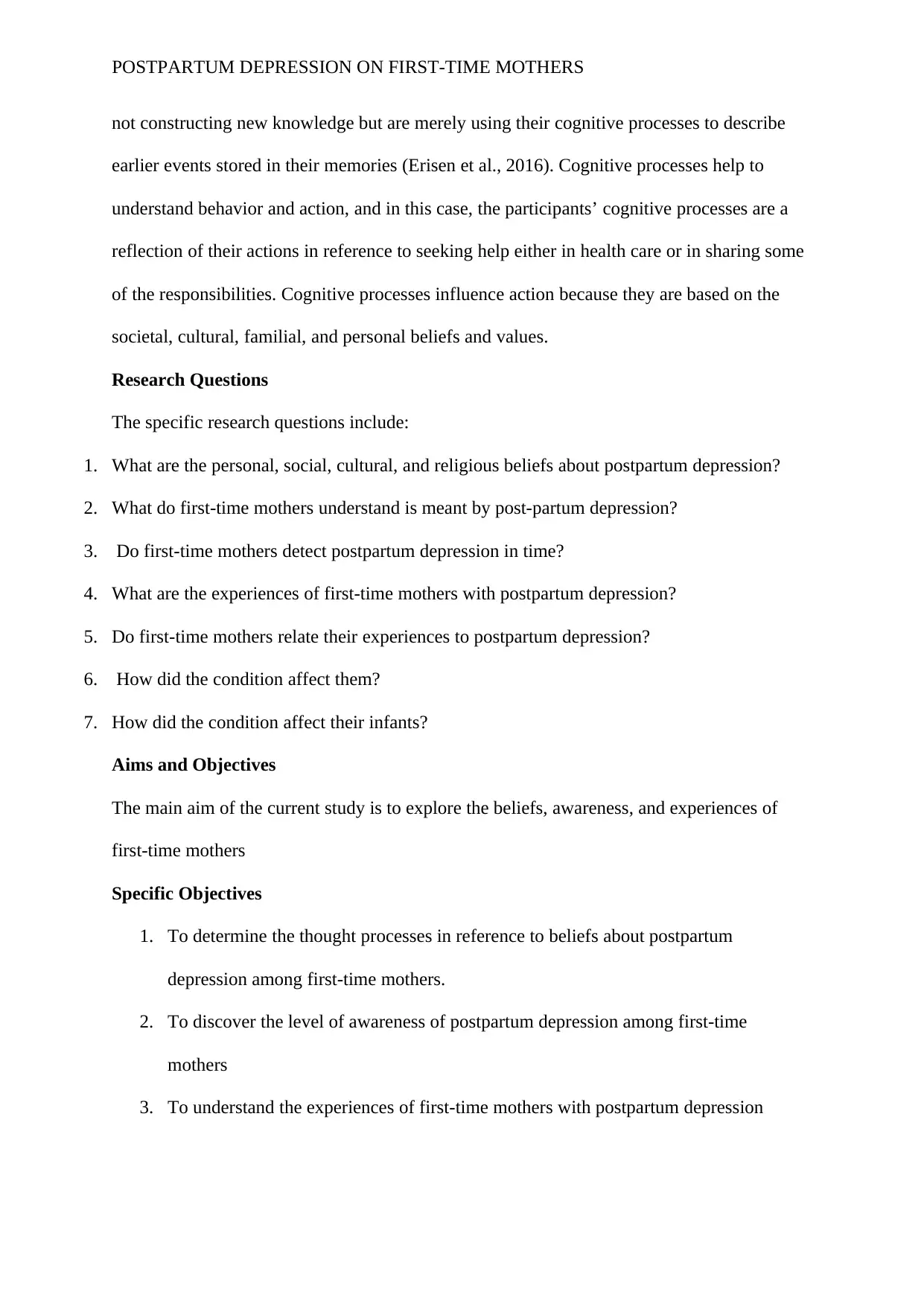
POSTPARTUM DEPRESSION ON FIRST-TIME MOTHERS
not constructing new knowledge but are merely using their cognitive processes to describe
earlier events stored in their memories (Erisen et al., 2016). Cognitive processes help to
understand behavior and action, and in this case, the participants’ cognitive processes are a
reflection of their actions in reference to seeking help either in health care or in sharing some
of the responsibilities. Cognitive processes influence action because they are based on the
societal, cultural, familial, and personal beliefs and values.
Research Questions
The specific research questions include:
1. What are the personal, social, cultural, and religious beliefs about postpartum depression?
2. What do first-time mothers understand is meant by post-partum depression?
3. Do first-time mothers detect postpartum depression in time?
4. What are the experiences of first-time mothers with postpartum depression?
5. Do first-time mothers relate their experiences to postpartum depression?
6. How did the condition affect them?
7. How did the condition affect their infants?
Aims and Objectives
The main aim of the current study is to explore the beliefs, awareness, and experiences of
first-time mothers
Specific Objectives
1. To determine the thought processes in reference to beliefs about postpartum
depression among first-time mothers.
2. To discover the level of awareness of postpartum depression among first-time
mothers
3. To understand the experiences of first-time mothers with postpartum depression
not constructing new knowledge but are merely using their cognitive processes to describe
earlier events stored in their memories (Erisen et al., 2016). Cognitive processes help to
understand behavior and action, and in this case, the participants’ cognitive processes are a
reflection of their actions in reference to seeking help either in health care or in sharing some
of the responsibilities. Cognitive processes influence action because they are based on the
societal, cultural, familial, and personal beliefs and values.
Research Questions
The specific research questions include:
1. What are the personal, social, cultural, and religious beliefs about postpartum depression?
2. What do first-time mothers understand is meant by post-partum depression?
3. Do first-time mothers detect postpartum depression in time?
4. What are the experiences of first-time mothers with postpartum depression?
5. Do first-time mothers relate their experiences to postpartum depression?
6. How did the condition affect them?
7. How did the condition affect their infants?
Aims and Objectives
The main aim of the current study is to explore the beliefs, awareness, and experiences of
first-time mothers
Specific Objectives
1. To determine the thought processes in reference to beliefs about postpartum
depression among first-time mothers.
2. To discover the level of awareness of postpartum depression among first-time
mothers
3. To understand the experiences of first-time mothers with postpartum depression

POSTPARTUM DEPRESSION ON FIRST-TIME MOTHERS
4. To identify the gaps in healthcare that need to be redressed in developing effective
and holistic healthcare services for pregnant and lactating women
Suppositions
-Women from limited resource settings have low educational attainment and lack adequate
social support.
4. To identify the gaps in healthcare that need to be redressed in developing effective
and holistic healthcare services for pregnant and lactating women
Suppositions
-Women from limited resource settings have low educational attainment and lack adequate
social support.
Paraphrase This Document
Need a fresh take? Get an instant paraphrase of this document with our AI Paraphraser
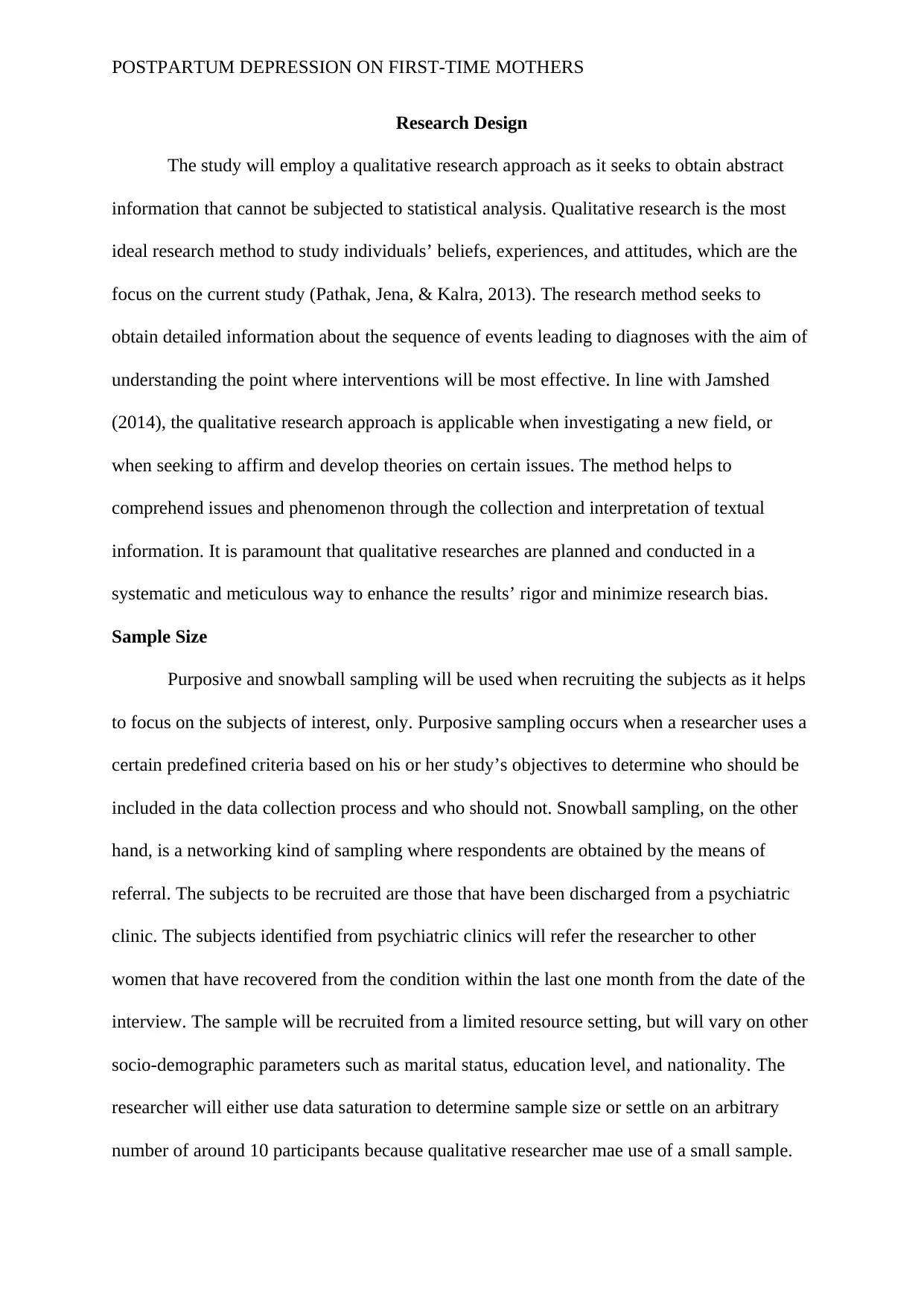
POSTPARTUM DEPRESSION ON FIRST-TIME MOTHERS
Research Design
The study will employ a qualitative research approach as it seeks to obtain abstract
information that cannot be subjected to statistical analysis. Qualitative research is the most
ideal research method to study individuals’ beliefs, experiences, and attitudes, which are the
focus on the current study (Pathak, Jena, & Kalra, 2013). The research method seeks to
obtain detailed information about the sequence of events leading to diagnoses with the aim of
understanding the point where interventions will be most effective. In line with Jamshed
(2014), the qualitative research approach is applicable when investigating a new field, or
when seeking to affirm and develop theories on certain issues. The method helps to
comprehend issues and phenomenon through the collection and interpretation of textual
information. It is paramount that qualitative researches are planned and conducted in a
systematic and meticulous way to enhance the results’ rigor and minimize research bias.
Sample Size
Purposive and snowball sampling will be used when recruiting the subjects as it helps
to focus on the subjects of interest, only. Purposive sampling occurs when a researcher uses a
certain predefined criteria based on his or her study’s objectives to determine who should be
included in the data collection process and who should not. Snowball sampling, on the other
hand, is a networking kind of sampling where respondents are obtained by the means of
referral. The subjects to be recruited are those that have been discharged from a psychiatric
clinic. The subjects identified from psychiatric clinics will refer the researcher to other
women that have recovered from the condition within the last one month from the date of the
interview. The sample will be recruited from a limited resource setting, but will vary on other
socio-demographic parameters such as marital status, education level, and nationality. The
researcher will either use data saturation to determine sample size or settle on an arbitrary
number of around 10 participants because qualitative researcher mae use of a small sample.
Research Design
The study will employ a qualitative research approach as it seeks to obtain abstract
information that cannot be subjected to statistical analysis. Qualitative research is the most
ideal research method to study individuals’ beliefs, experiences, and attitudes, which are the
focus on the current study (Pathak, Jena, & Kalra, 2013). The research method seeks to
obtain detailed information about the sequence of events leading to diagnoses with the aim of
understanding the point where interventions will be most effective. In line with Jamshed
(2014), the qualitative research approach is applicable when investigating a new field, or
when seeking to affirm and develop theories on certain issues. The method helps to
comprehend issues and phenomenon through the collection and interpretation of textual
information. It is paramount that qualitative researches are planned and conducted in a
systematic and meticulous way to enhance the results’ rigor and minimize research bias.
Sample Size
Purposive and snowball sampling will be used when recruiting the subjects as it helps
to focus on the subjects of interest, only. Purposive sampling occurs when a researcher uses a
certain predefined criteria based on his or her study’s objectives to determine who should be
included in the data collection process and who should not. Snowball sampling, on the other
hand, is a networking kind of sampling where respondents are obtained by the means of
referral. The subjects to be recruited are those that have been discharged from a psychiatric
clinic. The subjects identified from psychiatric clinics will refer the researcher to other
women that have recovered from the condition within the last one month from the date of the
interview. The sample will be recruited from a limited resource setting, but will vary on other
socio-demographic parameters such as marital status, education level, and nationality. The
researcher will either use data saturation to determine sample size or settle on an arbitrary
number of around 10 participants because qualitative researcher mae use of a small sample.
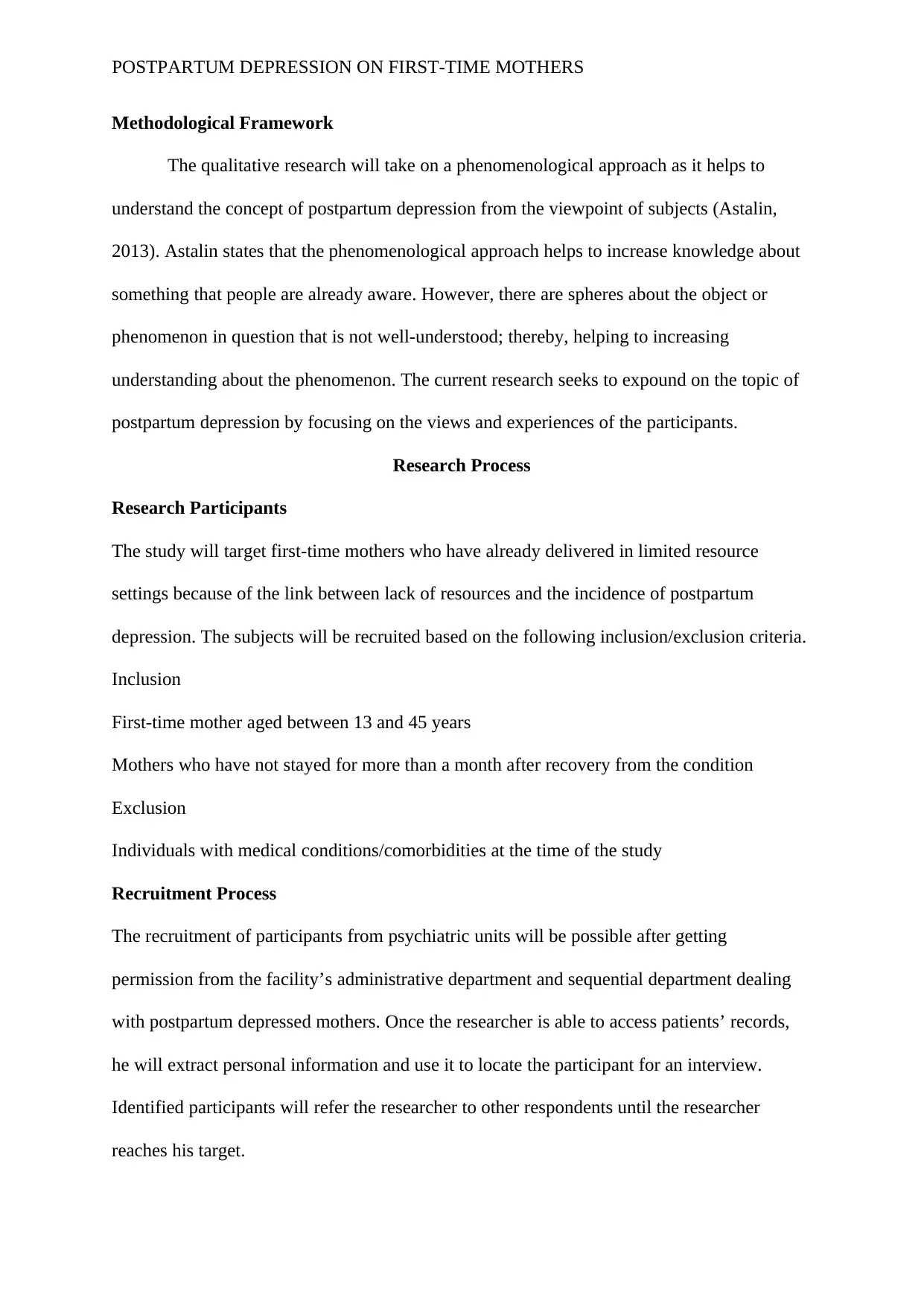
POSTPARTUM DEPRESSION ON FIRST-TIME MOTHERS
Methodological Framework
The qualitative research will take on a phenomenological approach as it helps to
understand the concept of postpartum depression from the viewpoint of subjects (Astalin,
2013). Astalin states that the phenomenological approach helps to increase knowledge about
something that people are already aware. However, there are spheres about the object or
phenomenon in question that is not well-understood; thereby, helping to increasing
understanding about the phenomenon. The current research seeks to expound on the topic of
postpartum depression by focusing on the views and experiences of the participants.
Research Process
Research Participants
The study will target first-time mothers who have already delivered in limited resource
settings because of the link between lack of resources and the incidence of postpartum
depression. The subjects will be recruited based on the following inclusion/exclusion criteria.
Inclusion
First-time mother aged between 13 and 45 years
Mothers who have not stayed for more than a month after recovery from the condition
Exclusion
Individuals with medical conditions/comorbidities at the time of the study
Recruitment Process
The recruitment of participants from psychiatric units will be possible after getting
permission from the facility’s administrative department and sequential department dealing
with postpartum depressed mothers. Once the researcher is able to access patients’ records,
he will extract personal information and use it to locate the participant for an interview.
Identified participants will refer the researcher to other respondents until the researcher
reaches his target.
Methodological Framework
The qualitative research will take on a phenomenological approach as it helps to
understand the concept of postpartum depression from the viewpoint of subjects (Astalin,
2013). Astalin states that the phenomenological approach helps to increase knowledge about
something that people are already aware. However, there are spheres about the object or
phenomenon in question that is not well-understood; thereby, helping to increasing
understanding about the phenomenon. The current research seeks to expound on the topic of
postpartum depression by focusing on the views and experiences of the participants.
Research Process
Research Participants
The study will target first-time mothers who have already delivered in limited resource
settings because of the link between lack of resources and the incidence of postpartum
depression. The subjects will be recruited based on the following inclusion/exclusion criteria.
Inclusion
First-time mother aged between 13 and 45 years
Mothers who have not stayed for more than a month after recovery from the condition
Exclusion
Individuals with medical conditions/comorbidities at the time of the study
Recruitment Process
The recruitment of participants from psychiatric units will be possible after getting
permission from the facility’s administrative department and sequential department dealing
with postpartum depressed mothers. Once the researcher is able to access patients’ records,
he will extract personal information and use it to locate the participant for an interview.
Identified participants will refer the researcher to other respondents until the researcher
reaches his target.

POSTPARTUM DEPRESSION ON FIRST-TIME MOTHERS
Interview
The phenomenon under study will be understood by engaging the participants in an in-depth
interview. The use of interviews is a common research method, and it should be progressively
challenged and reinforced during the entire research process (Jamshed. 2014). These
interviews are either in-depth, semi-structured, or unstructured. The unstructured interviews
are used in long-term researches while the semi-structured interviews are ideal in the current
research. These semi-structured are in-depth, and can be conducted with a small number of
first-time mothers as it explores their perspectives on elements of interest in details.
The use of these in-depth interviews is justified in this study because it sees to study
the participants’ thoughts and life processes (Boyce & Neale, 2006). The interviews will be
recorded, and consent for recording will be obtained from the participants. The researcher
will interview the respondents in languages that are familiar to him apart from English.
Data Analysis
The recorded verbatim will be transcribed and the transcript will be coded. In view
the fact that the verbatim will be in a different language other than English, the researcher
will seek the services of a translator. Subsequently, the codes will be grouped into sub-themes
that will help in the development of major themes using thematic analysis (Maguire &
Delahunt, 2017). A concept map will be developed, and it will help to generate the major
themes by interlinking related sub-themes to come up with a major theme.
Limitations
The main anticipated limitation is researcher reflexivity, which occurs when the
researcher fails to acknowledge his or her influence on the entire research process (Patnaik,
2013). Qualitative research does not follow a structure sequence during data collection and
the researcher’s knowledge is likely to cause a shift during an interview process. Another
limitation is recall bias because the study will target mothers who have already been through
Interview
The phenomenon under study will be understood by engaging the participants in an in-depth
interview. The use of interviews is a common research method, and it should be progressively
challenged and reinforced during the entire research process (Jamshed. 2014). These
interviews are either in-depth, semi-structured, or unstructured. The unstructured interviews
are used in long-term researches while the semi-structured interviews are ideal in the current
research. These semi-structured are in-depth, and can be conducted with a small number of
first-time mothers as it explores their perspectives on elements of interest in details.
The use of these in-depth interviews is justified in this study because it sees to study
the participants’ thoughts and life processes (Boyce & Neale, 2006). The interviews will be
recorded, and consent for recording will be obtained from the participants. The researcher
will interview the respondents in languages that are familiar to him apart from English.
Data Analysis
The recorded verbatim will be transcribed and the transcript will be coded. In view
the fact that the verbatim will be in a different language other than English, the researcher
will seek the services of a translator. Subsequently, the codes will be grouped into sub-themes
that will help in the development of major themes using thematic analysis (Maguire &
Delahunt, 2017). A concept map will be developed, and it will help to generate the major
themes by interlinking related sub-themes to come up with a major theme.
Limitations
The main anticipated limitation is researcher reflexivity, which occurs when the
researcher fails to acknowledge his or her influence on the entire research process (Patnaik,
2013). Qualitative research does not follow a structure sequence during data collection and
the researcher’s knowledge is likely to cause a shift during an interview process. Another
limitation is recall bias because the study will target mothers who have already been through
Secure Best Marks with AI Grader
Need help grading? Try our AI Grader for instant feedback on your assignments.
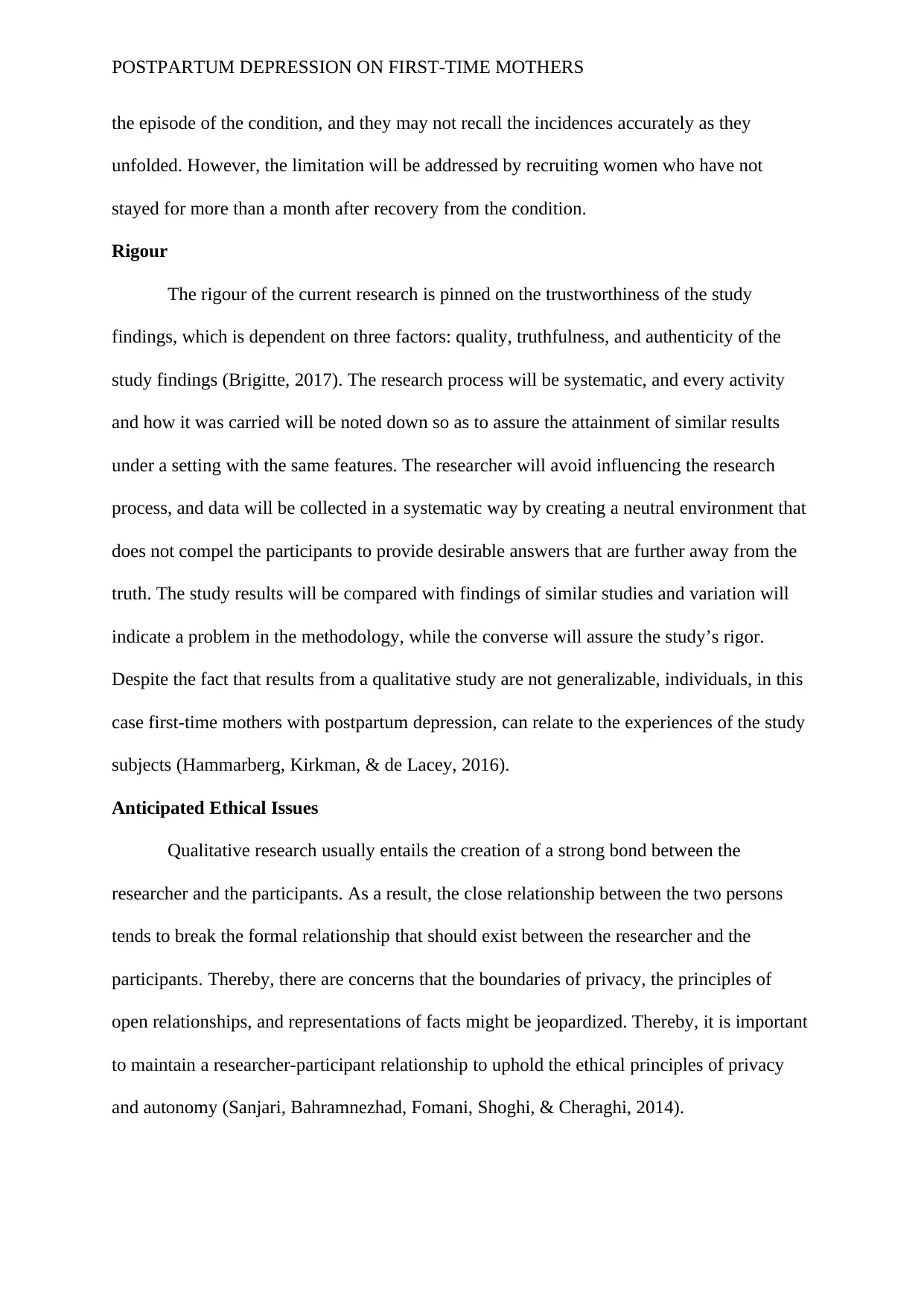
POSTPARTUM DEPRESSION ON FIRST-TIME MOTHERS
the episode of the condition, and they may not recall the incidences accurately as they
unfolded. However, the limitation will be addressed by recruiting women who have not
stayed for more than a month after recovery from the condition.
Rigour
The rigour of the current research is pinned on the trustworthiness of the study
findings, which is dependent on three factors: quality, truthfulness, and authenticity of the
study findings (Brigitte, 2017). The research process will be systematic, and every activity
and how it was carried will be noted down so as to assure the attainment of similar results
under a setting with the same features. The researcher will avoid influencing the research
process, and data will be collected in a systematic way by creating a neutral environment that
does not compel the participants to provide desirable answers that are further away from the
truth. The study results will be compared with findings of similar studies and variation will
indicate a problem in the methodology, while the converse will assure the study’s rigor.
Despite the fact that results from a qualitative study are not generalizable, individuals, in this
case first-time mothers with postpartum depression, can relate to the experiences of the study
subjects (Hammarberg, Kirkman, & de Lacey, 2016).
Anticipated Ethical Issues
Qualitative research usually entails the creation of a strong bond between the
researcher and the participants. As a result, the close relationship between the two persons
tends to break the formal relationship that should exist between the researcher and the
participants. Thereby, there are concerns that the boundaries of privacy, the principles of
open relationships, and representations of facts might be jeopardized. Thereby, it is important
to maintain a researcher-participant relationship to uphold the ethical principles of privacy
and autonomy (Sanjari, Bahramnezhad, Fomani, Shoghi, & Cheraghi, 2014).
the episode of the condition, and they may not recall the incidences accurately as they
unfolded. However, the limitation will be addressed by recruiting women who have not
stayed for more than a month after recovery from the condition.
Rigour
The rigour of the current research is pinned on the trustworthiness of the study
findings, which is dependent on three factors: quality, truthfulness, and authenticity of the
study findings (Brigitte, 2017). The research process will be systematic, and every activity
and how it was carried will be noted down so as to assure the attainment of similar results
under a setting with the same features. The researcher will avoid influencing the research
process, and data will be collected in a systematic way by creating a neutral environment that
does not compel the participants to provide desirable answers that are further away from the
truth. The study results will be compared with findings of similar studies and variation will
indicate a problem in the methodology, while the converse will assure the study’s rigor.
Despite the fact that results from a qualitative study are not generalizable, individuals, in this
case first-time mothers with postpartum depression, can relate to the experiences of the study
subjects (Hammarberg, Kirkman, & de Lacey, 2016).
Anticipated Ethical Issues
Qualitative research usually entails the creation of a strong bond between the
researcher and the participants. As a result, the close relationship between the two persons
tends to break the formal relationship that should exist between the researcher and the
participants. Thereby, there are concerns that the boundaries of privacy, the principles of
open relationships, and representations of facts might be jeopardized. Thereby, it is important
to maintain a researcher-participant relationship to uphold the ethical principles of privacy
and autonomy (Sanjari, Bahramnezhad, Fomani, Shoghi, & Cheraghi, 2014).
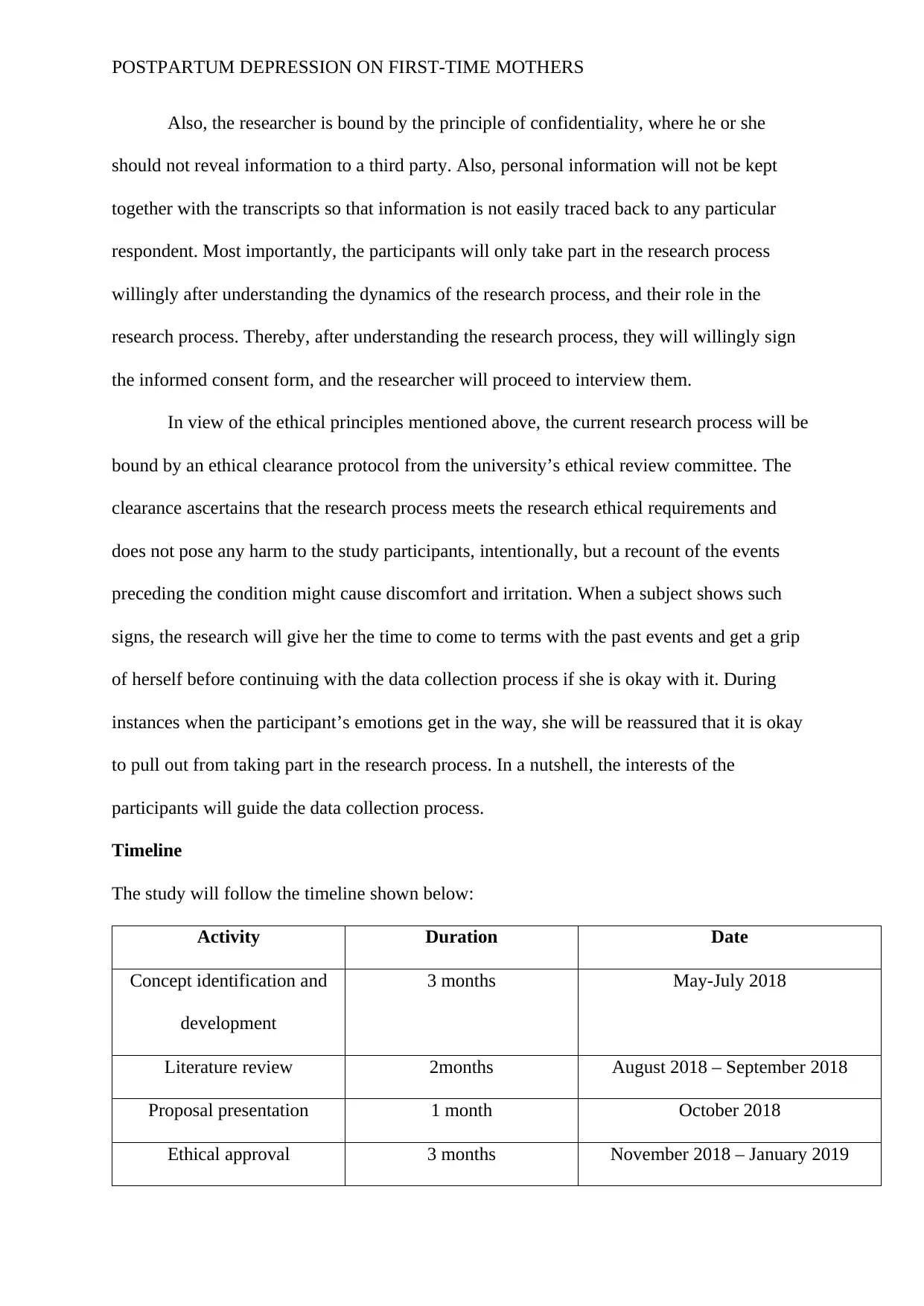
POSTPARTUM DEPRESSION ON FIRST-TIME MOTHERS
Also, the researcher is bound by the principle of confidentiality, where he or she
should not reveal information to a third party. Also, personal information will not be kept
together with the transcripts so that information is not easily traced back to any particular
respondent. Most importantly, the participants will only take part in the research process
willingly after understanding the dynamics of the research process, and their role in the
research process. Thereby, after understanding the research process, they will willingly sign
the informed consent form, and the researcher will proceed to interview them.
In view of the ethical principles mentioned above, the current research process will be
bound by an ethical clearance protocol from the university’s ethical review committee. The
clearance ascertains that the research process meets the research ethical requirements and
does not pose any harm to the study participants, intentionally, but a recount of the events
preceding the condition might cause discomfort and irritation. When a subject shows such
signs, the research will give her the time to come to terms with the past events and get a grip
of herself before continuing with the data collection process if she is okay with it. During
instances when the participant’s emotions get in the way, she will be reassured that it is okay
to pull out from taking part in the research process. In a nutshell, the interests of the
participants will guide the data collection process.
Timeline
The study will follow the timeline shown below:
Activity Duration Date
Concept identification and
development
3 months May-July 2018
Literature review 2months August 2018 – September 2018
Proposal presentation 1 month October 2018
Ethical approval 3 months November 2018 – January 2019
Also, the researcher is bound by the principle of confidentiality, where he or she
should not reveal information to a third party. Also, personal information will not be kept
together with the transcripts so that information is not easily traced back to any particular
respondent. Most importantly, the participants will only take part in the research process
willingly after understanding the dynamics of the research process, and their role in the
research process. Thereby, after understanding the research process, they will willingly sign
the informed consent form, and the researcher will proceed to interview them.
In view of the ethical principles mentioned above, the current research process will be
bound by an ethical clearance protocol from the university’s ethical review committee. The
clearance ascertains that the research process meets the research ethical requirements and
does not pose any harm to the study participants, intentionally, but a recount of the events
preceding the condition might cause discomfort and irritation. When a subject shows such
signs, the research will give her the time to come to terms with the past events and get a grip
of herself before continuing with the data collection process if she is okay with it. During
instances when the participant’s emotions get in the way, she will be reassured that it is okay
to pull out from taking part in the research process. In a nutshell, the interests of the
participants will guide the data collection process.
Timeline
The study will follow the timeline shown below:
Activity Duration Date
Concept identification and
development
3 months May-July 2018
Literature review 2months August 2018 – September 2018
Proposal presentation 1 month October 2018
Ethical approval 3 months November 2018 – January 2019

POSTPARTUM DEPRESSION ON FIRST-TIME MOTHERS
Data collection 6 months February 2019 – July 2019
Data analysis 5 months August 2019 – December 2019
Report write up 3 months January 2020 – March 2020
Submission 1 month April 2020
Data collection 6 months February 2019 – July 2019
Data analysis 5 months August 2019 – December 2019
Report write up 3 months January 2020 – March 2020
Submission 1 month April 2020
Paraphrase This Document
Need a fresh take? Get an instant paraphrase of this document with our AI Paraphraser
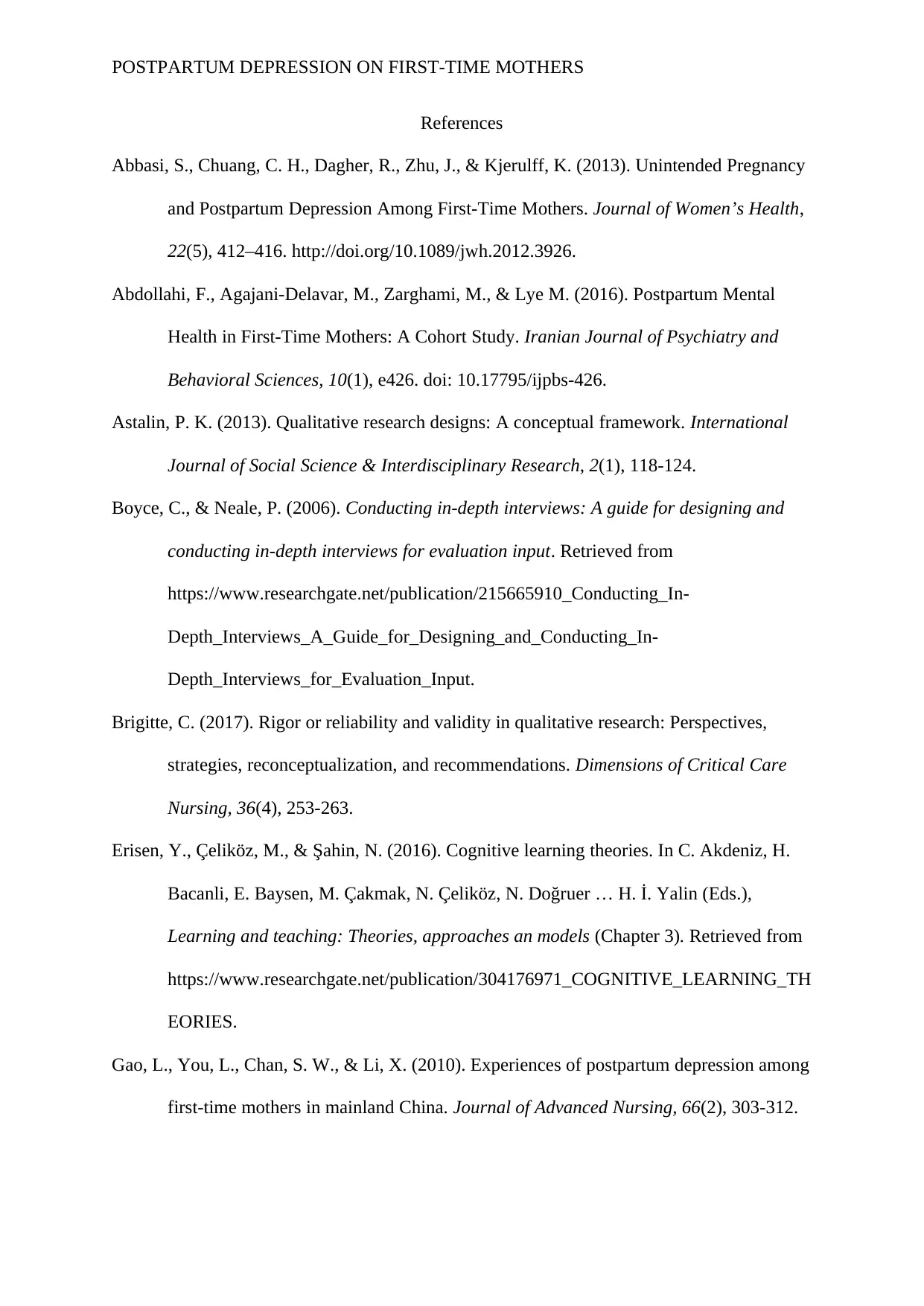
POSTPARTUM DEPRESSION ON FIRST-TIME MOTHERS
References
Abbasi, S., Chuang, C. H., Dagher, R., Zhu, J., & Kjerulff, K. (2013). Unintended Pregnancy
and Postpartum Depression Among First-Time Mothers. Journal of Women’s Health,
22(5), 412–416. http://doi.org/10.1089/jwh.2012.3926.
Abdollahi, F., Agajani-Delavar, M., Zarghami, M., & Lye M. (2016). Postpartum Mental
Health in First-Time Mothers: A Cohort Study. Iranian Journal of Psychiatry and
Behavioral Sciences, 10(1), e426. doi: 10.17795/ijpbs-426.
Astalin, P. K. (2013). Qualitative research designs: A conceptual framework. International
Journal of Social Science & Interdisciplinary Research, 2(1), 118-124.
Boyce, C., & Neale, P. (2006). Conducting in-depth interviews: A guide for designing and
conducting in-depth interviews for evaluation input. Retrieved from
https://www.researchgate.net/publication/215665910_Conducting_In-
Depth_Interviews_A_Guide_for_Designing_and_Conducting_In-
Depth_Interviews_for_Evaluation_Input.
Brigitte, C. (2017). Rigor or reliability and validity in qualitative research: Perspectives,
strategies, reconceptualization, and recommendations. Dimensions of Critical Care
Nursing, 36(4), 253-263.
Erisen, Y., Çeliköz, M., & Şahin, N. (2016). Cognitive learning theories. In C. Akdeniz, H.
Bacanli, E. Baysen, M. Çakmak, N. Çeliköz, N. Doğruer … H. İ. Yalin (Eds.),
Learning and teaching: Theories, approaches an models (Chapter 3). Retrieved from
https://www.researchgate.net/publication/304176971_COGNITIVE_LEARNING_TH
EORIES.
Gao, L., You, L., Chan, S. W., & Li, X. (2010). Experiences of postpartum depression among
first-time mothers in mainland China. Journal of Advanced Nursing, 66(2), 303-312.
References
Abbasi, S., Chuang, C. H., Dagher, R., Zhu, J., & Kjerulff, K. (2013). Unintended Pregnancy
and Postpartum Depression Among First-Time Mothers. Journal of Women’s Health,
22(5), 412–416. http://doi.org/10.1089/jwh.2012.3926.
Abdollahi, F., Agajani-Delavar, M., Zarghami, M., & Lye M. (2016). Postpartum Mental
Health in First-Time Mothers: A Cohort Study. Iranian Journal of Psychiatry and
Behavioral Sciences, 10(1), e426. doi: 10.17795/ijpbs-426.
Astalin, P. K. (2013). Qualitative research designs: A conceptual framework. International
Journal of Social Science & Interdisciplinary Research, 2(1), 118-124.
Boyce, C., & Neale, P. (2006). Conducting in-depth interviews: A guide for designing and
conducting in-depth interviews for evaluation input. Retrieved from
https://www.researchgate.net/publication/215665910_Conducting_In-
Depth_Interviews_A_Guide_for_Designing_and_Conducting_In-
Depth_Interviews_for_Evaluation_Input.
Brigitte, C. (2017). Rigor or reliability and validity in qualitative research: Perspectives,
strategies, reconceptualization, and recommendations. Dimensions of Critical Care
Nursing, 36(4), 253-263.
Erisen, Y., Çeliköz, M., & Şahin, N. (2016). Cognitive learning theories. In C. Akdeniz, H.
Bacanli, E. Baysen, M. Çakmak, N. Çeliköz, N. Doğruer … H. İ. Yalin (Eds.),
Learning and teaching: Theories, approaches an models (Chapter 3). Retrieved from
https://www.researchgate.net/publication/304176971_COGNITIVE_LEARNING_TH
EORIES.
Gao, L., You, L., Chan, S. W., & Li, X. (2010). Experiences of postpartum depression among
first-time mothers in mainland China. Journal of Advanced Nursing, 66(2), 303-312.
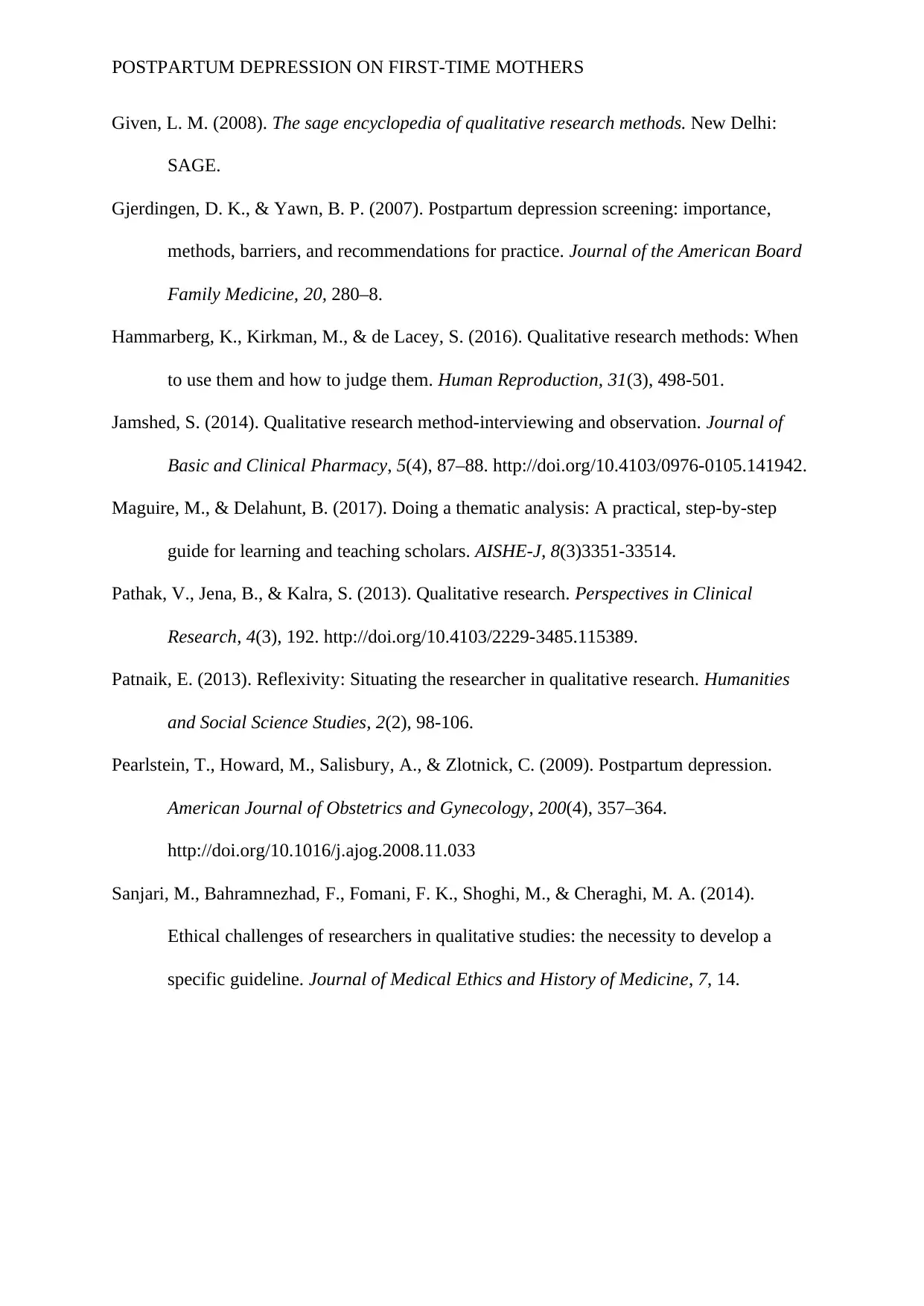
POSTPARTUM DEPRESSION ON FIRST-TIME MOTHERS
Given, L. M. (2008). The sage encyclopedia of qualitative research methods. New Delhi:
SAGE.
Gjerdingen, D. K., & Yawn, B. P. (2007). Postpartum depression screening: importance,
methods, barriers, and recommendations for practice. Journal of the American Board
Family Medicine, 20, 280–8.
Hammarberg, K., Kirkman, M., & de Lacey, S. (2016). Qualitative research methods: When
to use them and how to judge them. Human Reproduction, 31(3), 498-501.
Jamshed, S. (2014). Qualitative research method-interviewing and observation. Journal of
Basic and Clinical Pharmacy, 5(4), 87–88. http://doi.org/10.4103/0976-0105.141942.
Maguire, M., & Delahunt, B. (2017). Doing a thematic analysis: A practical, step-by-step
guide for learning and teaching scholars. AISHE-J, 8(3)3351-33514.
Pathak, V., Jena, B., & Kalra, S. (2013). Qualitative research. Perspectives in Clinical
Research, 4(3), 192. http://doi.org/10.4103/2229-3485.115389.
Patnaik, E. (2013). Reflexivity: Situating the researcher in qualitative research. Humanities
and Social Science Studies, 2(2), 98-106.
Pearlstein, T., Howard, M., Salisbury, A., & Zlotnick, C. (2009). Postpartum depression.
American Journal of Obstetrics and Gynecology, 200(4), 357–364.
http://doi.org/10.1016/j.ajog.2008.11.033
Sanjari, M., Bahramnezhad, F., Fomani, F. K., Shoghi, M., & Cheraghi, M. A. (2014).
Ethical challenges of researchers in qualitative studies: the necessity to develop a
specific guideline. Journal of Medical Ethics and History of Medicine, 7, 14.
Given, L. M. (2008). The sage encyclopedia of qualitative research methods. New Delhi:
SAGE.
Gjerdingen, D. K., & Yawn, B. P. (2007). Postpartum depression screening: importance,
methods, barriers, and recommendations for practice. Journal of the American Board
Family Medicine, 20, 280–8.
Hammarberg, K., Kirkman, M., & de Lacey, S. (2016). Qualitative research methods: When
to use them and how to judge them. Human Reproduction, 31(3), 498-501.
Jamshed, S. (2014). Qualitative research method-interviewing and observation. Journal of
Basic and Clinical Pharmacy, 5(4), 87–88. http://doi.org/10.4103/0976-0105.141942.
Maguire, M., & Delahunt, B. (2017). Doing a thematic analysis: A practical, step-by-step
guide for learning and teaching scholars. AISHE-J, 8(3)3351-33514.
Pathak, V., Jena, B., & Kalra, S. (2013). Qualitative research. Perspectives in Clinical
Research, 4(3), 192. http://doi.org/10.4103/2229-3485.115389.
Patnaik, E. (2013). Reflexivity: Situating the researcher in qualitative research. Humanities
and Social Science Studies, 2(2), 98-106.
Pearlstein, T., Howard, M., Salisbury, A., & Zlotnick, C. (2009). Postpartum depression.
American Journal of Obstetrics and Gynecology, 200(4), 357–364.
http://doi.org/10.1016/j.ajog.2008.11.033
Sanjari, M., Bahramnezhad, F., Fomani, F. K., Shoghi, M., & Cheraghi, M. A. (2014).
Ethical challenges of researchers in qualitative studies: the necessity to develop a
specific guideline. Journal of Medical Ethics and History of Medicine, 7, 14.
1 out of 15
Related Documents
Your All-in-One AI-Powered Toolkit for Academic Success.
+13062052269
info@desklib.com
Available 24*7 on WhatsApp / Email
![[object Object]](/_next/static/media/star-bottom.7253800d.svg)
Unlock your academic potential
© 2024 | Zucol Services PVT LTD | All rights reserved.





